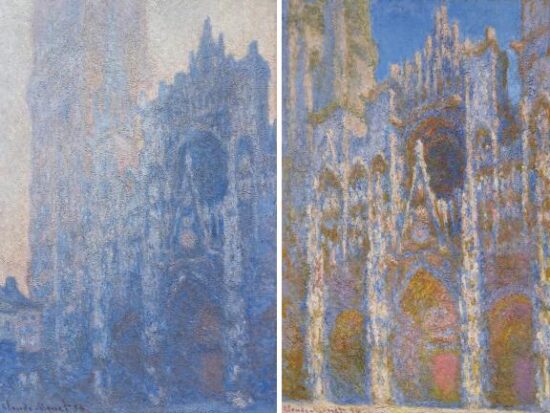
In 1888, when Claude Monet moved to Normandy, he was already a skilled painter with an established reputation. His 1872 work entitled Impression, Sunrise moved a Paris art critic to refer to the sketchy, atmospheric style in which it was executed as impressionistic and the movement it inspired as Impressionism.
The work marked a departure from Monet’s earlier, more conventional and naturalistic style. Unsatisfied with trying to capture the essence of the view of a given landscape within a single static frame, he began an ambitious series of canvases that depicted the same scene at different times of day and under various atmospheric conditions. Inside a rented room across from the cathedral at Rouen, he worked on multiple paintings of the church’s west facade (above), moving from one to the other as the light changed during the day.
The result was a representation of reality more realistic than painting had been before, in one sense at least, since it attempted to account for the important fact that the world as we perceive it is never still, and that the view from our window at one moment can never be exactly the same as it was even an hour earlier.
In the world of wine today, great emphasis is laid on the particular place where grapes are grown. It is a combination of the durable features of a given spot, such as soil condition and composition, elevation and situation that gives wine grown there its own special character. The shorthand term for these features is a French loan word: terroir.
A given terror is thought to be a stable and unvarying thing; the winemaker’s job to let it shine, through in all its ineffable solidity and permanence, in the glass. But, as Monet would no doubt affirm, it doesn’t really work that way.
This is because terroir is something that can’t be got at apart from a constellation of factors that affect our perception of the thing itself. Meterological hazards and variations in disease pressure attend every vintage, are unpredictable and vary in their effects. Personal preferences in craft practice among winemakers account for significant deviations from the norm, and even the temperature and context in which wine is consumed play roles. Enveloped in this surround sound of effects, it becomes hard to tease out what might behind it all.
Like Monet’s church which can’t be viewed apart from the light and shade, fog and moonlight that wrap it, wine, too, only exists within an enfolding perceptual aura.
Monet would understand. To every vintage, its fresh canvas.